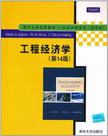工程经济学
出版时间:2011-2 出版社:沙利文(William G.Sullivan)、威克斯(Elin M.Wicks)、 科林(C.Patrick Koelling) 清华大学出版社 (2011-02出版) 作者:沙利文(William G.Sullivan) 等 著 页数:668
Tag标签:无
内容概要
《工程经济学(第14版)(影印版)》是工程经济学领域的畅销教材,麻省理工学院等数十所美国大学以及英国、韩国、新加坡等很多国家的一些知名院校都将《工程经济学(第14版)(影印版)》作为“工程经济学”课程的最主要教材。 《工程经济学(第14版)(影印版)》系统介绍了工程经济分析的理论、原理、方法和应用案例。全书共分为3部分。第1部分是工程经济基本原理,主要阐述工程经济分析的基本原则、重要的成本概念和估计技术、货币时间价值原理等工程经济学的基本概念和原理;第2部分介绍工程经济基本方法,深入分析了投资方案的赢利性评价方法和比选方法,折旧、所得税、通货膨胀等对评价方法的影响,设备更新分析方法,不确定性分析方法;第3部分为工程经济分析方法特别专题,内容包括公共项目的费用效益分析方法、风险分析技术和融资及资本预算方法。 《工程经济学(第14版)(影印版)》适合作为经济类、管理类、工业工程及相关专业本科生或研究生的教材。
作者简介
作者:(美国)沙利文(William G.Sullivan) (美国)威克斯(Elin M.Wicks) (美国)科林(C.Patrick Koelling)
书籍目录
PrefaceAcknowledgmentsPART 1 Fundamentals of Engineering EconomyCHAPTER 1Introduction to Engineering Economy1.1 Introduction1.2 The Principles of Engineering Economy1.3 Engineering Economy and the Design Process1.4 Using Spreadsheets in Engineering Economic Analysis1.5 SummaryCHAPTER 2Cost Concepts and Design Economics2.1 Cost Terminology2.2 The General Economic Environment2.3 Cost-Driven Design Optimization2.4 Present Economy Studies2.5 Case Study——The Economics of Daytime Running Lights2.6 SummaryAppendix 2-A Accounting FundamentalsCHAPTER 3Cost-Estimation Techniques3.1 Introduction3.2 An Integrated Approach3.3 Selected Estimating Techniques (Models)3.4 Parametric Cost Estimating3.5 Cost Estimation in the Design Process3.6 Case Study——Demanufacturing of Computers3.7 SummaryCHAPTER 4The Time Value of Money4.1 Introduction4.2 Simple Interest4.3 Compound Interest4.4 The Concept of Equivalence4.5 Notation and Cash-Flow Diagrams and Tables4.6 Relating Present and Future Equivalent Values of Single Cash Flows4.7 Relating a Uniform Series (Annuity) to Its Present and Future Equivalent Values4.8 Summary of Interest Formulas and Relationships for Discrete Compounding4.9 Deferred Annuities (Uniform Series)4.10 Equivalence Calculations Involving Multiple Interest Formulas4.11 Uniform (Arithmetic) Gradient of Cash Flows4.12 Geometric Sequences of Cash Flows4.13 Interest Rates that Vary with Time4.14 Nominal and Effective Interest Rates4.15 Compounding More Often than Once per Year4.16 Interest Formulas for Continuous Compounding and Discrete Cash Flows4.17 Case Study——Understanding Economic “Equivalence”4.18 SummaryPart II Engineering Economy in ActionCHAPTER 5Evaluating a Single Project5.1 Introduction5.2 Determining the Minimum Attractive Rate of Return (MARR)5.3 The Present Worth Method5.4 The Future Worth Method5.5 The Annual Worth Method5.6 The Internal Rate of Return Method5.7 The External Rate of Return Method5.8 The Payback (Payout) Period Method5.9 Case Study——A Proposed Capital Investment to Improve Process Yield5.10 SummaryAppendix 5-A The Multiple Rate of Return Problem with the IRR Method……Part III Additional Topics in Engineering EconomyPart IV Appendices
章节摘录
版权页:插图:2.1.2 Direct, Indirect, and Standard CostsThese frequently encountered cost terms involve most of the cost elements that also fit into the previous overlapping categories of fixed and variable costs and recurring and nonrecurring costs. Direct costs are costs that can be reasonably measured and allocated to a specific output or work activity. The labor and material costs directly associated with a product, service, or construction activity are direct costs. For example, the materials needed to make a pair of scissors would be a direct cost.Indirect costs are costs that are difficult to attribute or allocate to a specific output or work activity. Normally, they are costs allocated through a selected formula (such as proportional to direct labor hours, direct labor dollars, or direct material dollars) to the outputs or work activities. For example, the costs of common tools, general supplies, and equipment maintenance in a plant are treated as indirect costs.Overhead consists of plant operating costs that are not direct labor or direct material costs. In this book, the terms indirect costs, overhead, and burden are used interchangeably. Examples of overhead include electricity, general repairs, property taxes, and supervision. Administrative and selling expenses are usually added to direct costs and overhead costs to arrive at a unit selling price for a product or service. (Appendix 2-A provides a more detailed discussion of cost accounting principles.)Standard costs are planned costs per unit of output that are established in advance of actual production or service delivery. They are developed from anticipated direct labor hours, materials, and overhead categories (with their established costs per unit). Because total overhead costs are associated with a certain level of production, this is an important condition that should be remembered when dealing with standard cost data (for example, see Section 2.4.3). Standard costs play an important role in cost control and other management functions. Some typical uses are the following:1. Estimating future manufacturing costs2. Measuring operating performance by comparing actual cost per unit with the standard unit cost3. Preparing bids on products or services requested by customers4. Establishing the value of work in process and finished inventories
编辑推荐
《工程经济学(第14版)》:国外大学优秀教材·工业工程系列。
图书封面
图书标签Tags
无
评论、评分、阅读与下载
用户评论 (总计5条)
- 排除语言的因素,这本书是非常适合自学的,要比国内的教材好学的多的多。
- 学工程的同志们,这本书该看一看!
- This book provides explicit explanation on engineering economy. It is too great for one with only limited economic sense.
- 很好的书。值得投资。发货快速。价格合适
- 影印版的,还可以,就是图片效果不大好。
